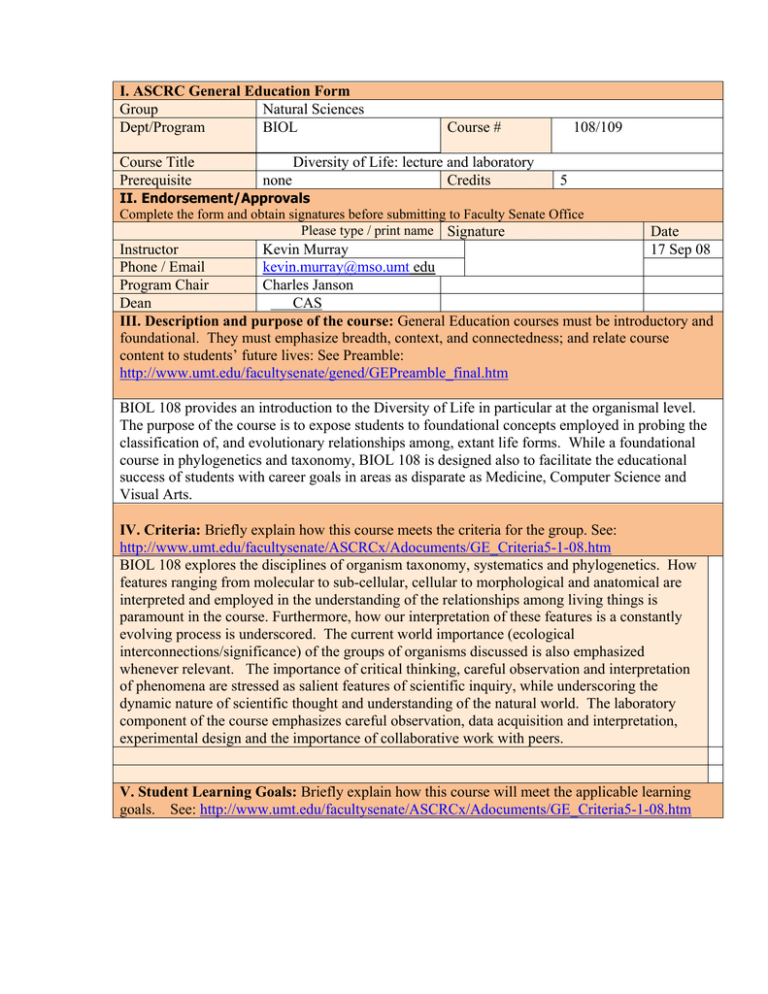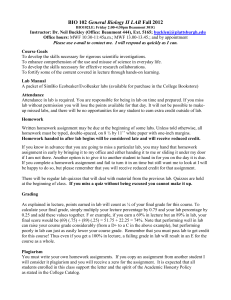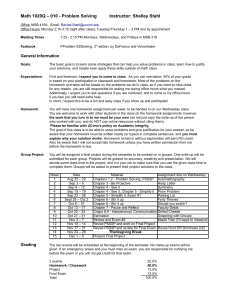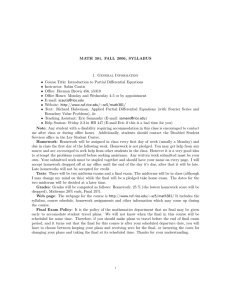I. ASCRC General Education Form Group Natural Sciences Dept/Program
advertisement

I. ASCRC General Education Form Group Natural Sciences Dept/Program BIOL Course Title Prerequisite none Course # Diversity of Life: lecture and laboratory Credits 108/109 5 II. Endorsement/Approvals Complete the form and obtain signatures before submitting to Faculty Senate Office Please type / print name Signature Date Instructor Kevin Murray 17 Sep 08 Phone / Email kevin.murray@mso.umt edu Program Chair Charles Janson Dean CAS III. Description and purpose of the course: General Education courses must be introductory and foundational. They must emphasize breadth, context, and connectedness; and relate course content to students’ future lives: See Preamble: http://www.umt.edu/facultysenate/gened/GEPreamble_final.htm BIOL 108 provides an introduction to the Diversity of Life in particular at the organismal level. The purpose of the course is to expose students to foundational concepts employed in probing the classification of, and evolutionary relationships among, extant life forms. While a foundational course in phylogenetics and taxonomy, BIOL 108 is designed also to facilitate the educational success of students with career goals in areas as disparate as Medicine, Computer Science and Visual Arts. IV. Criteria: Briefly explain how this course meets the criteria for the group. See: http://www.umt.edu/facultysenate/ASCRCx/Adocuments/GE_Criteria5-1-08.htm BIOL 108 explores the disciplines of organism taxonomy, systematics and phylogenetics. How features ranging from molecular to sub-cellular, cellular to morphological and anatomical are interpreted and employed in the understanding of the relationships among living things is paramount in the course. Furthermore, how our interpretation of these features is a constantly evolving process is underscored. The current world importance (ecological interconnections/significance) of the groups of organisms discussed is also emphasized whenever relevant. The importance of critical thinking, careful observation and interpretation of phenomena are stressed as salient features of scientific inquiry, while underscoring the dynamic nature of scientific thought and understanding of the natural world. The laboratory component of the course emphasizes careful observation, data acquisition and interpretation, experimental design and the importance of collaborative work with peers. V. Student Learning Goals: Briefly explain how this course will meet the applicable learning goals. See: http://www.umt.edu/facultysenate/ASCRCx/Adocuments/GE_Criteria5-1-08.htm Upon completion of BIOL 108 students will have a broader and deeper understanding of the diversity, relationships, ecology and importance of numerous forms of extant living things. How science is an on-going process of observation and interpretation, driven by advances in numerous fields which serve to facilitate these observations and interpretations is an additional course objective. Furthermore the importance of select groups of organisms studied in BIOL 108/109 in terms of human culture and society is emphasized. The skills developed in laboratory and the precision thinking required to understand concepts explored in lecture will provide students with an appreciation of the rigors encountered in scientific research. Students will also be prepared to better interpret important sociological and cultural dilemmas related to the natural sciences. VII. Syllabus: Paste syllabus below or attach and send digital copy with form. ⇓ The syllabus should clearly describe how the above criteria are satisfied. For assistance on syllabus preparation see: http://teaching.berkeley.edu/bgd/syllabus.html BIO 108 Principles of Biology: Diversity of Life Course Syllabus and Lecture Outline Fall 2008 Professor: Dr. Kevin Murray Office: NS 113; office hours 10-12 Tues Contact information: phone 4495; email: kevin.murray@mso.umt.edu; Class meeting times: MWF, 1-2 pm; NULH 101 Required text: Biology 8th edition. Campbell, Reece et al. 2008. Course scope and objectives. The diversity in form and function encountered among living organisms is astounding. From a single cell, to a simple organism such as a jellyfish, to plants and ecological communities, living things exhibit a staggering hierarchy of complex organization. Nothing found in the abiotic world (non-living systems such water, rocks, stars and yes, even computers and other man-made machines) comes close to the complexity of even a single cell. Biological diversity manifests on many levels. For instance, we may refer to the diversity in form and function of mammal fore-limbs, or the variety of organelles found in a eukaryotic cell, the number of species in an ecosystem or even the number of different ecosystems that make-up a biome. From a temporal perspective we should also note the diverse parade of living innovations represented in the evolutionary history of life on earth. In BIOL 108 we cannot address all of the many levels of biological diversity on earth. Our focus will be instead on the major categories of living things, ranging from unicellular bacteria, to protists, plants, fungi and animals. We will strive to attain a complete picture of the mosaic of life on earth, and, importantly, how the pieces of this mosaic (major taxonomic groups) are related to one another. For instance, consider a small pond. Within even a relatively limited ecosystem such as a freshwater pond we could likely find representatives of all major forms of life earth: bacteria, protists, plants, fungi and animals, each represented in probably numerous forms (species). BIOL 108 will provide you with principles needed to understand many things about life in that pond as well as throughout the biosphere: What is a protist? How do protists differ from each other and from other organisms such as plants and animals? What makes an “animal” an animal? Are all green, photosynthetic organisms plants? And many more questions about life on earth. Grading. There will be 3 regular session exams and a final exam; the final is partly comprehensive. Exams are objective (true/false, multiple choice). Each regular session exam will be worth approximately 75 points; the final 100 points. Your grade will be calculated as a percentage of total possible exam points. You will require SCANTRONS for lecture exams. Fundamentally, the following grading scheme will be used: 100 – 90% = A; 89.9 – 80% = B; 79.9 – 70% = C; 69.9 – 55% = D; < 55% = F Classroom attendance, make-up exams, extra-credit. Your participation in classroom discussions may affect your final grade; please attend class on a regular basis. Disruptive behavior such as talking or leaving lecture early is not acceptable. If you expect to leave class early, please tell Professor before class begins. Make-up exams will be permitted only with compelling and supported reasons. Make-up exams will take place one week after the scheduled exam, immediately after class (2:00 – 3:00 pm). Extra-credit assignments may be arranged only under exceptional circumstances; please contact Professor Murray for more information. Mastering Biology. You new textbook comes with an outstanding learning tool: Mastering Biology. This dynamic website incorporates many features, two of which we will employ over the course of the semester. 1) The Study Area: provides individual or group review of topic covered in lecture and text. 2) MasteringBiology Assignments: includes assignments and feedback for students and instructor regarding students understanding of principles covered in course. Completion of assignments will contribute to approximately 15% of your overall course grade. Note that these assignments are not graded in the traditional sense. Lecture Notes. Undoubtedly, the art of taking clear, concise lectures notes will be one of your most valuable skills as a University student and beyond. Therefore, come prepared to class with a dedicated notebook. Date your entries and strive to keep complete, organized lecture notes. Also, a proven method of learning is the re-writing of lecture notes. This will greatly assist your comprehension of the material. If you wish to view lecture material again (we employ Power Point media), you may do so during the office hours posted by your lab instructor. BIOL 108 Lecture Topic Schedule Fall, 2008 Date Topic Text readings 25 Aug 27 Aug 29 Aug Course introduction Nature of life: molecular level Nature of life: cell structure 68-90 94-123 01 Sep 03 Sep 05 Sep no class Nature of life: cell cycle The Tree of Life; Phylogenetics 228-233; 248-255 536-540; 551-553 08 Sep 10 Sep 12 Sep Prokaryotes: intro Prokaryotes: metabolism & diversity Prokaryotes: ecological relationships 556-560 564-569 570-573 15 Sep 17 Sep 19 Sep Exam I Protists: origins & intro Protist diversity 1 575-579 580-584 22 Sep 24 Sep 26 Sep Protist diversity 2 Protist diversity 3 Protist diversity 4 585-588 589-596 597-598 29 Sep 01 Oct 03 Oct Fungi: origins & intro Fungi: diversity Fungi: ecological relationships 636-639 641-647 648-652 06 Oct 08 Oct 10 Oct Protist Fungi review Exam II Plants: origins & intro 600-605 13 Oct 15 Oct 17 Oct 20 Oct 22 Oct 24 Oct Plants: bryophytes Plants: bryophytes Plants: seedless vascular Plants: seed-bearing; intro Plants: gymnosperms Plants: gymnosperms 27 Oct 29 Oct 31 Oct Plants: angiosperms Plants: angiosperms Plant review 606-610 610-614 618-620 621-624 625-632 03 Nov 05 Nov 07 Nov Exam III Animals: origins & intro Animals: intro 654-660 661-665 10 Nov 12 Nov 14 Nov Animal diversity 1 Animal diversity 2 Animal diversity 3 670-673 674-677 678-682 17 Nov 19 Nov 21 Nov Animal diversity 4 Animal diversity 4 Animal diversity 5 683-692 24 Nov 26 Nov 28 Nov Animal diversity 6 no class (Thanksgiving) no class (Thanksgiving) 698-702 01 Dec 03 Dec 05 Dec Animal diversity 7 Animal diversity 8 Course summary 703-707 11 Dec Final exam (1:10 – 2:30 pm) Laboratory Syllabus and Exercise Schedule 693-695 BIOL 109 Fall, 2008 Labs meet in NS 203 or 202 Laboratory meets on M, T , W, Th, F. Consult your section number for meeting day/time. Lab Manual: Biology 109, Diversity of Life Laboratory. Compiled by Kevin Murray Laboratory Course Content BIOL 109 lab exercises are designed to accomplish 3 primary objectives: a) help you understand more completely, in an on-hands fashion, the diversity in form and function of living things, b) cultivate your self-directed, inquisitive and observation-based learning abilities, and c) experience a collaborative and communication-based learning/work environment. In most cases the lab exercises will overlap completely with lecture material. However, sometimes lab investigations parallel or expand further on lecture topics. In both cases however, you will be provided with as much background information as possible during the “Introduction” period of a lab session. Student Expectations BIOL 109 laboratory students are expected to follow the some basic course conditions: • Arrive on time for lab session ; please do not interfere with Instructors valuable (and somewhat time constrained) Introduction discussion. • Come to lab prepared for the investigation by reading over lab before-hand. It is at the discretion of your Instructor to give a quiz at the beginning of lab on the upcoming investigation, if she/he deems necessary. • Work in self-motivated but collaborative fashion with other individuals in your investigation group. • Attend the full 4-hour session, as your Instructor may present summary statements at close of lab. Furthermore each student is expected to help in lab clean-up and reorganization at the close of lab. Grading Your grade in BIOL 109 Laboratory will be determined as follows. • Performance on weekly quizzes that cover previous week activities. Each quiz (7 in total) will be worth 10 points. There will also be 3 lab practical exams (no quiz that week); see lab investigation schedule for dates. Each practical exam will be worth approximately 20 points. • Completion of 1 research paper on a topic of your choice related to and complementary to any of the lab exercises scheduled for this semester. Your Instructor will provide guidance on research paper format and library/internet research tools. 15 points. • Lab notebook. You are required to maintain an organized, lucid account of your studies in lab. This should include written descriptions of what you study each week, supplemented by illustrations (not graded on artistic capacity). 25 points • Additional points (up to 20) can be obtained by adherence to the above-listed Student Expectations. Note: BIOL 109 grade is not factored into lecture (BIOL 108) grade. BIOL 109 Laboratory Schedule Fall, 2008 Week of Lab investigation 25 Aug No labs 01 Sep Lab introduction. 08 Sep Using the microscope. 15 Sep Prokaryotes (Bacteria and disease) 22 Sep Protista I: Euglenozoa, Aveolata, Stramenopila, Foraminiferans 29 Sep Protista II: Amoebozoans, Rhodophyta, Chlorophyta 06 Oct Fungi (Lab Practical I: Prokaryotes, Protista I & II)) Zygomycota, Ascomycota, Basidiomycota, Deuteromycota, Lichens 13 Oct Plant Diversity I Bryophyta, Hepatophyta, Lycophyta, Pterophyta 20 Oct Plant Diversity II: Gymnosperms, Angiosperms 27 Oct Animal Diversity I (Lab Practical II: Fungi, Plant Diversity I & II Porifera, Cnidaria, Platyhelminthes, Annelida, Mollusca, Rotifera 03 Nov no labs 10 Nov no labs 17 Nov Animal Diversity II (Nematoda, Arthropoda); Lab practical III review 26 Nov no labs 03 Dec Animal Diversity III (Lab practical III: Animal Diversity I & II) Echinodermata, Chordata *Please note: As an instructor of a general education course, you will be expected to provide sample assessment items and corresponding responses to the Assessment Advisory Committee.




